On View
Free to Travel Once More, Ai Weiwei Is Having a Huge New York Moment
Four simultaneous shows pack a punch
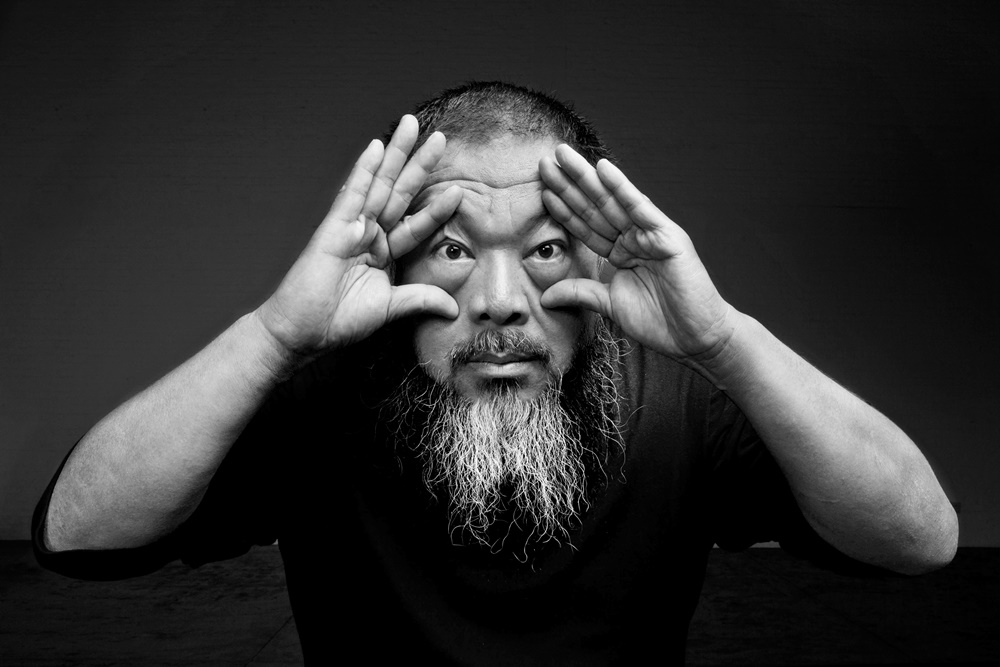
Four simultaneous shows pack a punch

Eileen Kinsella

Given that it is all but unprecedented for an artist to have four simultaneous gallery shows opening on the same day, it is fair to say that Ai Weiwei is having a New York moment this fall.
Fortuitiously, this moment comes four years after he was arrested and banned from leaving China, and just once year since his passport was returned by authorities.
In the interim, Manhattan—and especially the art world—have embraced Ai with open arms. Tomorrow (November 5) marks the official opening of four complementary gallery shows: the Fifth Avenue and Chelsea locations of Mary Boone Gallery, as well as Lisson Gallery’s most recently instituted branch in Chelsea, are exhibiting “Roots and Branches” while Jeffrey Deitch is exhibiting “Laundromat” at his Grand Street location in Soho.
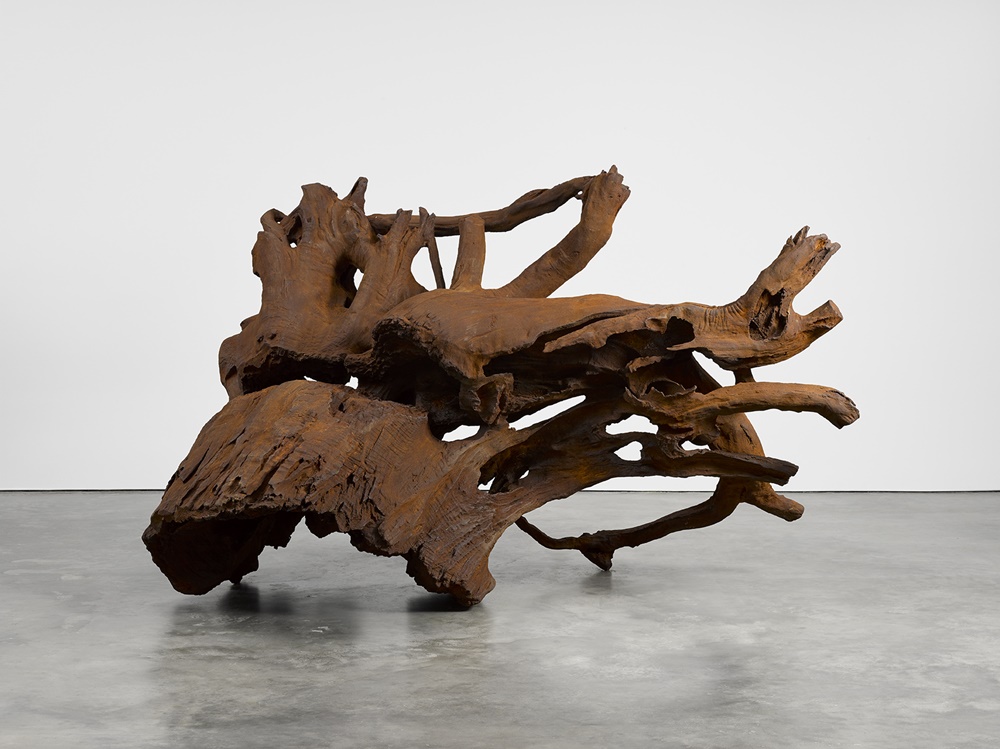
Ai Weiwei, Iron Root (2015). Courtesy the artist and Lisson Gallery.
“It’s a homecoming of sorts,” said Lisson Gallery international director Alex Logsdail to artnet News. “Weiwei has not had a show here that he has been able to see and install himself for a very long time.”
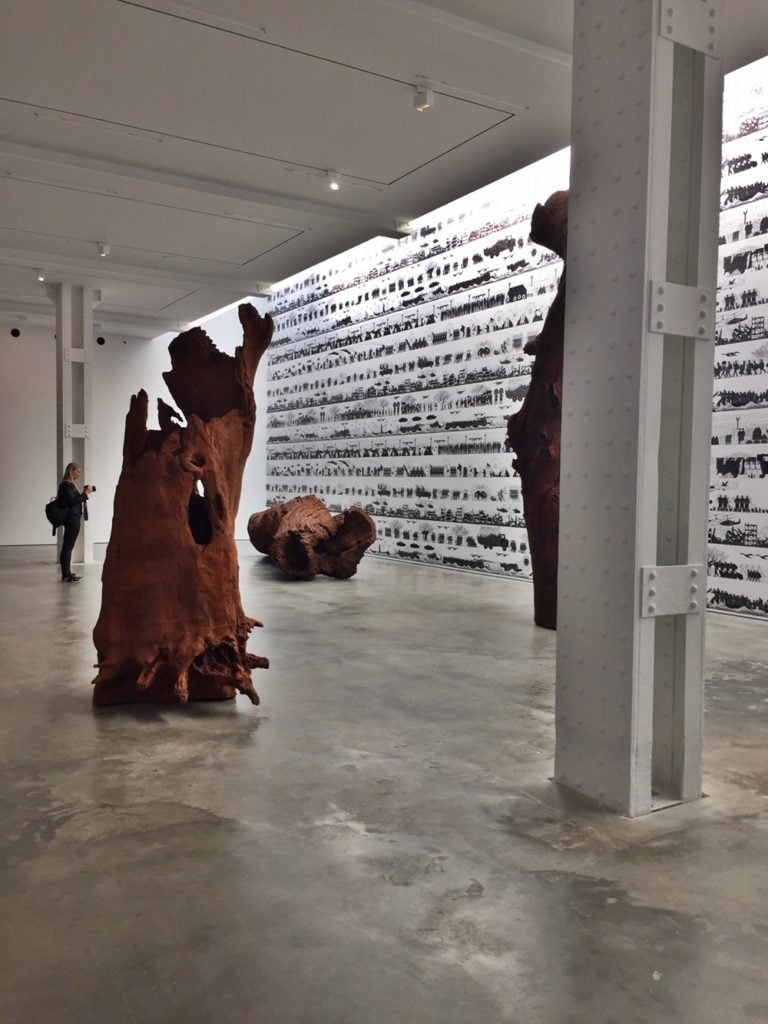
Installation view, Ai Weiwei “Roots and Branches” at Lisson Gallery. Courtesy Eileen Kinsella
We also spoke to Mary Boone director Ron Warren. He explained to artnet News: “We had offered him both [Boone] spaces and he had the idea for two very different installations. At the same time Lisson was opening their New York Gallery. With Weiwei newly available to travel, he had the idea for three distinct exhibitions, with the benefit of being in close proximity to each other. Each show is distinct but adds to the others and shows the breadth of Weiwei’s work.”
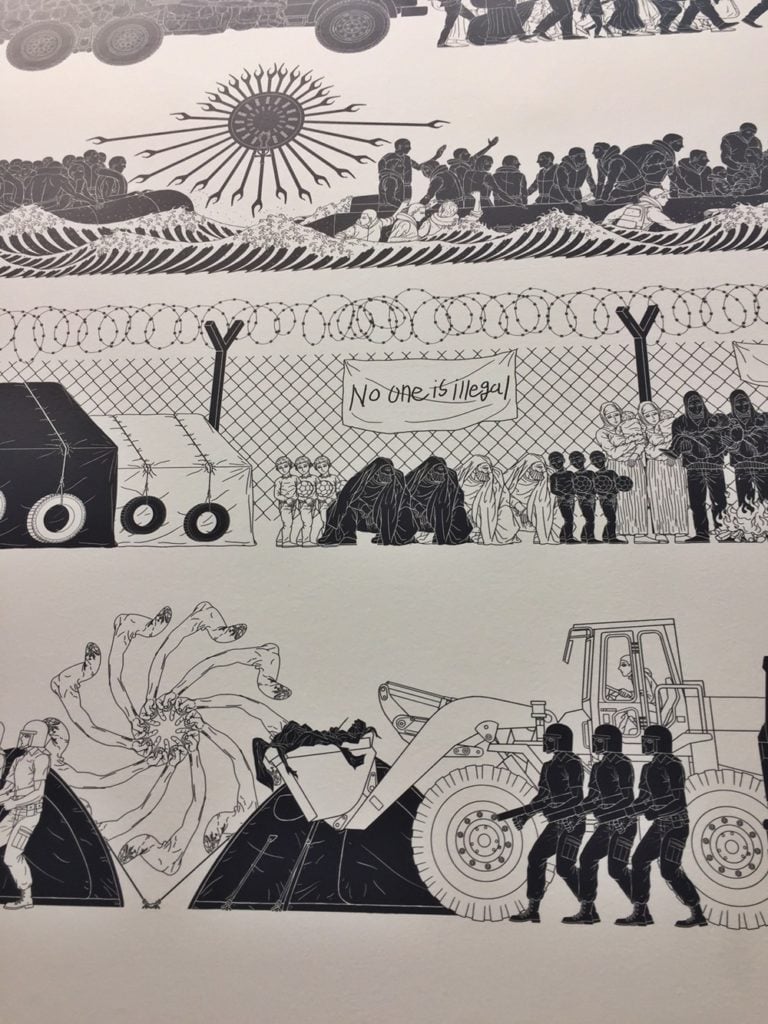
Detail of Ai Weiwei wallpaper at Lisson Gallery. Courtesy Eileen Kinsella
At Lisson, Ai has placed felled, cast-iron tree trunks and a series of iron root sculptures against the backdrop of a new, as of yet untitled black-and-white wallpaper installation that mixes ancient Greco-Roman style figures with modern day imagery, such as barbed wire and groups of refugees traipsing in lines or huddling together.
“Weiwei has an interest in wallpaper as a way to interrupt space,” says Logsdail. This particular work is “based around his research and experience in and around Greece relating to the Syrian refugee crisis. They’re in the style of a Greco-Roman frieze but with a modern twist. There is this foreshadowing and repetition of figures behind other figures. It marries the artist’s interest in design and art and humanitarian issues.”
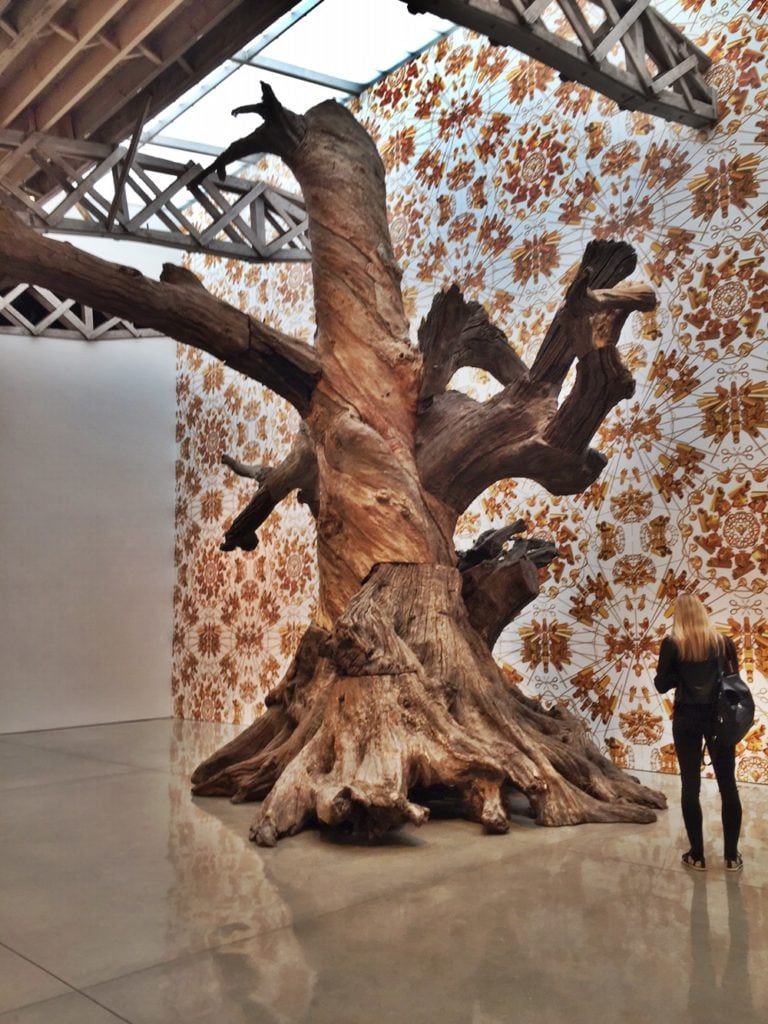
Installation view of Ai Weiwei “Roots and Branches,” at Mary Boone. Courtesy of Eileen Kinsella
At Mary Boone Chelsea, a towering wood structure, appropriately titled Tree, is actually a remade original structure shaped from weathered wood fragments, found in the mountains of Southern China, that Ai has bolted together as a sign of renewal. Wallpaper here features circular groups of gold surveillance cameras and gold “Twitter” birds, as well as Lego portraits of the artist famously dropping a Han Dynasty urn.
Throughout all of these shows, the artist continues his exploration of survival amid the displacement and destruction brought on by war, violence, and oppression, both in his native China and around the world. “Laundromat” at Deitch, is the most stark and grim of these exhibits, reflecting as it does Ai’s extensive exploration of refugee camps and in particular here, the plight of hundreds of thousands of individuals in the makeshift Idomeni camp on the Greece-Macedonia border.
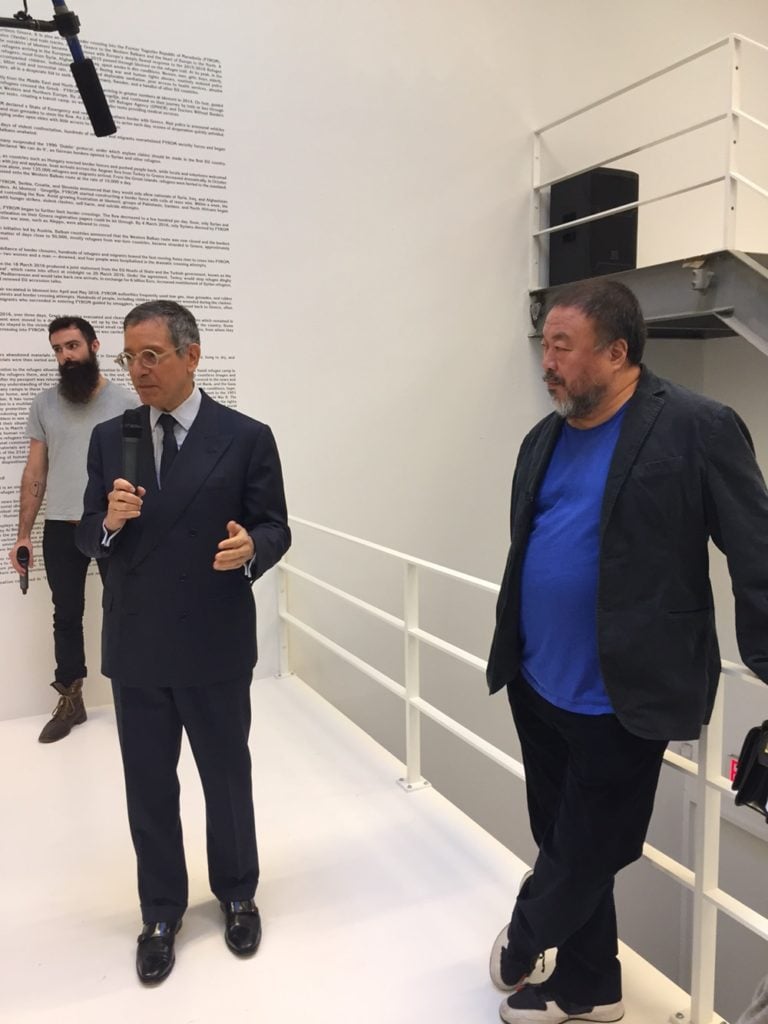
Jeffrey Deitch and Ai Weiwei at the opening of “Laundromat” at Deitch Projects. Courtesy Eileen Kinsella.
When the refugees were forced to leave for other camps, Ai gathered what they left behind: thousands of shoes, boots, jeans, jackets, shirts and other belongings. He has meticulously scrubbed, laundered, and pressed the items.
Now they are presented throughout the Deitch Projects space—like offerings at a Goodwill store— on racks with labels like “Pants $7.” A wallpaper installation displays a sprawling grid of photos showing Ai at the camp, where he is documenting the deplorable conditions and talking with the refugees. A video at the back of the gallery includes, among other scenes of daily life, horrific footage of Former Yugoslavia Republic of Macedonia Forces (FYROM) using tear gas and stun grenades to stem the flow of migrants.
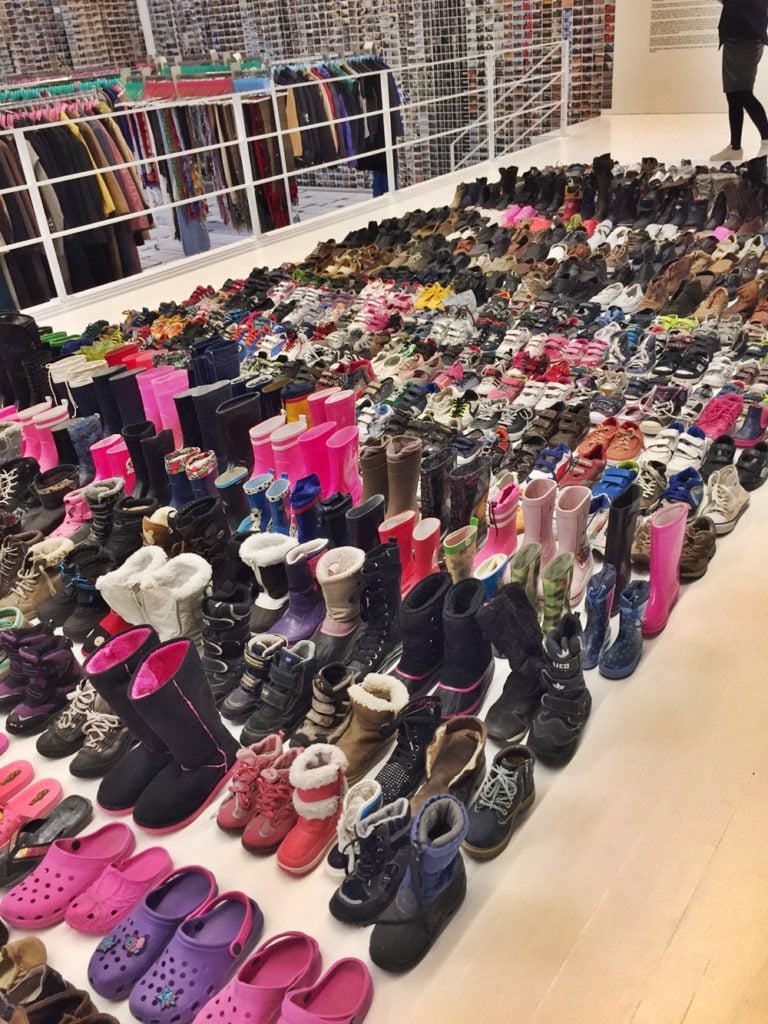
Ai Weiwei, “Laundromat” at Deitch Projects. Courtesy Eileen Kinsella
“I think that the work explains itself,” said Deitch at a press preview this morning, flanked by the artist, Alex Logsdail, and Mary Boone. “But there is a lot we learn from text and video, with the artist walking around the genesis of the project and seeing what it means to him. We understand so much more deeply every aspect of what he does.”
Not surprisingly, demand from collectors and institutions for Ai’s work is as robust as it has ever been. Logsdail said roughly half of the Lisson show is “on hold,” though interest tends to be institutional as these are not exactly “domestic” works. (The Deitch “Laundromat” show is a non-commercial project).
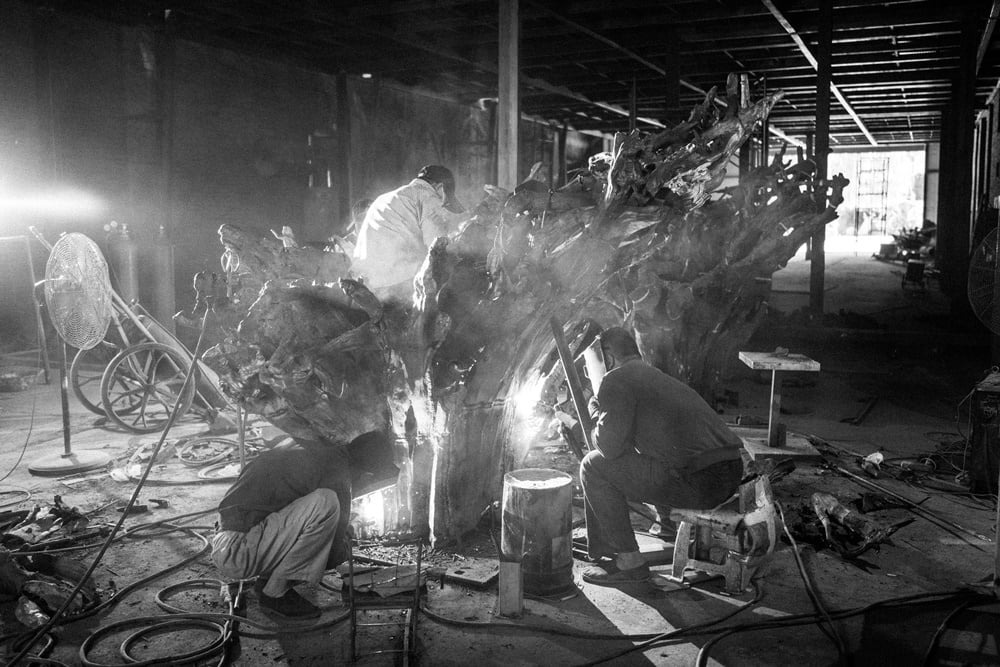
Ai Weiwei in production for Iron Root (2015). Courtesy of the artist and Lisson Gallery.
Auction prices give a sense of the depth and breadth of the artist’s work. According to the artnet Price database, the record for a work by Ai at auction is $5.4 million, paid for Circle of Animals/Zodiac Head (2010) at Phillips London in June 2015. The second highest price, $4.4 million, was also paid for a set of animal heads, offered at Phillips London in February 2015.
“Ai has a strong following around the world and his market remains consistently solid. His work has done very well at auction,” said Jonathan Crockett, deputy chairman, Asia, at Phillips auction house, in an email to artnet News. “Different bodies of work appeal to different geographical markets. His wooden sculptures, for example, tend to do best in Asia, whereas works that might reference Chinese art history or culture often do better in the West,” added Crockett.
Crockett said demand for Ai’s work has remained constant despite the numerous well-documented difficulties he has encountered as an artist over the course of his career.
Other top sellers at auction include a three dimensional Map of China (2009) made of iron (Tieli) wood from dismantled Qing Dynasty temples, which sold for $2.5 million at Christie’s New York this past May, and a triptych silver print, Dropping a Han Dynasty Urn—which shows the now famous act of the artist doing just that—sold for $1.9 million at Sotheby’s London in February 2016.
Ai’s audience seems to expand with his interest in sociopolitical and humanitarian issues. Said Crockett: “Since his passport was returned to him last year he immediately left China to join his family in Germany. This move coincided with the refugee crisis in Europe, something which had a dramatic effect on him and which resulted in a shift in focus in his work away from Chinese issues towards sociopolitical events with a more international context.”
At Deitch, both Logdsail and Boone gave opening remarks. Logsdail called the event “a momentous occasion,” saying “there is an immense power and weight behind all of these shows, and it’s very special to see them all at the same time.”
When the microphone was handed off to Ai, the artist simply added, “Thank you for coming. Enjoy the show.”